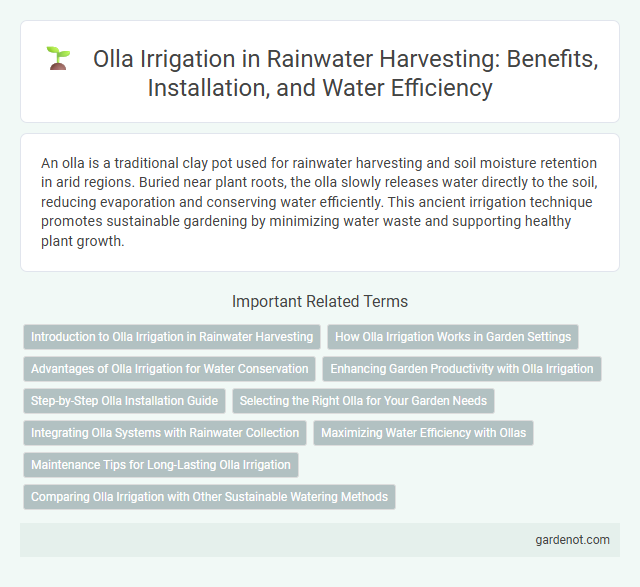An olla is a traditional clay pot used for rainwater harvesting and soil moisture retention in arid regions. Buried near plant roots, the olla slowly releases water directly to the soil, reducing evaporation and conserving water efficiently. This ancient irrigation technique promotes sustainable gardening by minimizing water waste and supporting healthy plant growth.
Introduction to Olla Irrigation in Rainwater Harvesting
Olla irrigation is an ancient, water-efficient technique used in rainwater harvesting that involves burying unglazed clay pots in the soil to deliver water directly to plant roots through slow seepage. These porous pots reduce water evaporation and runoff, making them ideal for arid regions with limited rainfall. Integrating olla irrigation enhances soil moisture retention, supports sustainable agriculture, and conserves harvested rainwater effectively.
How Olla Irrigation Works in Garden Settings
Olla irrigation utilizes porous clay pots buried near plant roots to deliver water directly where it is needed, minimizing evaporation and runoff. Water seeps slowly through the olla's walls, maintaining consistent soil moisture and promoting healthy root growth. This traditional, efficient rainwater harvesting method can reduce overall water usage by up to 50% in garden settings.
Advantages of Olla Irrigation for Water Conservation
Olla irrigation enhances water conservation by delivering moisture directly to plant roots, minimizing evaporation and runoff. Its porous clay design ensures slow, consistent water release, reducing water waste and improving soil moisture retention. This traditional method supports sustainable agriculture in arid regions by maximizing water-use efficiency and promoting healthier plant growth.
Enhancing Garden Productivity with Olla Irrigation
Olla irrigation significantly boosts garden productivity by providing a slow, consistent water supply directly to plant roots, reducing water waste and promoting healthier plant growth. These porous clay pots release moisture gradually, ensuring optimal soil hydration and minimizing evaporation. Their effectiveness in drought-prone areas makes ollas an eco-friendly solution for sustainable garden irrigation.
Step-by-Step Olla Installation Guide
To install an olla for rainwater harvesting, begin by selecting a location close to the plants you intend to irrigate, ensuring the soil is well-draining. Excavate a hole slightly larger than the olla's diameter, then place the olla upright and fill the surrounding gap with soil to stabilize it. Connect the top opening to a rainwater source or cover it with a lid to minimize evaporation, then regularly monitor soil moisture to optimize irrigation efficiency.
Selecting the Right Olla for Your Garden Needs
Choosing the right olla involves considering your garden size, soil type, and plant water requirements to maximize efficiency. Porous clay ollas with appropriate capacities ensure slow water release, reducing evaporation and deep percolation losses. Position ollas near root zones to optimize moisture availability and enhance drought resilience in diverse planting setups.
Integrating Olla Systems with Rainwater Collection
Olla systems significantly enhance rainwater harvesting by providing efficient, subsurface irrigation that reduces water evaporation and runoff. Integrating ollas with rainwater collection involves channeling harvested rainwater directly into these porous clay pots buried near plant roots, optimizing water use in arid and semi-arid regions. This method improves soil moisture retention, supports sustainable gardening practices, and lowers dependence on conventional watering systems.
Maximizing Water Efficiency with Ollas
Ollas enhance rainwater harvesting by delivering a highly efficient irrigation system that reduces water evaporation and runoff. These porous clay pots slowly release water directly to plant roots, optimizing soil moisture retention and minimizing water waste. Incorporating ollas in garden or agricultural settings maximizes water efficiency, especially in drought-prone or arid regions.
Maintenance Tips for Long-Lasting Olla Irrigation
Regularly clean the Olla to prevent algae buildup and ensure efficient water absorption. Inspect for cracks or damage and repair them promptly to maintain proper functionality. Position the Olla away from direct sunlight to reduce evaporation and extend its lifespan.
Comparing Olla Irrigation with Other Sustainable Watering Methods
Olla irrigation uses porous clay pots buried in soil to slowly release water directly to plant roots, significantly reducing evaporation compared to drip irrigation and surface watering. This method conserves water more effectively than traditional sprinkler systems by minimizing runoff and deep percolation losses. Its low cost, ease of maintenance, and ability to maintain consistent soil moisture make olla irrigation a superior sustainable watering technique in arid and semi-arid regions.
Olla Infographic

 gardenot.com
gardenot.com